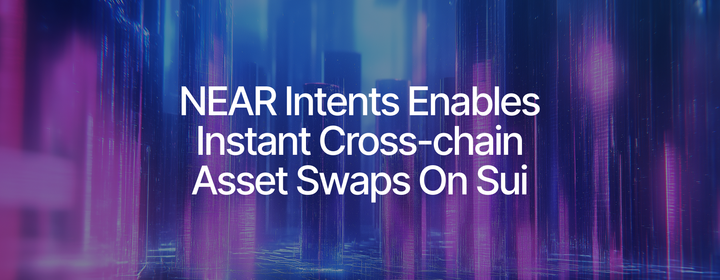Sui Delivers Infrastructure-friendly Tokenomics
Sui’s economic model is tailored to operate in sync with its pioneering design to create a platform that is low-cost and high-performance.

Sui is a permissionless Layer 1 blockchain network designed to be cost-efficient, with high-throughput and low-latency: the performance trifecta necessary to serve as the foundational technology for everyday products that serve millions. The superior performance of Sui is enabled by major advancements in the fields of distributed systems, cryptography, and programming languages. But advancements in engineering and technology are not enough. Sui’s economics and incentives—also known as Sui’s tokenomics—have also been designed at the frontier of blockchain research. The goal of its design is a flourishing economy where all participants' incentives are appropriately aligned; fees must be low enough for retail customers to want to use the chain, building costs must be low and predictable for businesses to have a sustainable business model, and activity must be large and reliable enough for operators to plan their IT budgets.
This post summarizes how Sui’s tokenomics operates so that it can work in harmony with the technology to create a developer- and user-friendly platform that can support activity from millions of users.
Alonso de Gortari, Head Economist at Mysten Labs, explains Sui's tokenomics
Players in the Sui Economy
The Sui economy has three main sets of participants:
- users who submit transactions to the platform to create, change, or transfer digital assets or interact with applications built on Sui
- SUI token holders who either stake their funds to validators in order to secure the network and participate in governance or use them to pay fees to interact with assets and applications on the chain
- validators who manage transaction processing and execution
These participants interact with each other in a variety of ways across the network and that interplay informs the three core components of Sui’s tokenomics:
- Sui’s Proof-of-Stake Mechanism ensures the incentives of SUI token holders are in line with Sui’s validators
- Sui’s Gas Mechanism ensures the network charges low and stable gas fees to users no matter how much demand there is for activity on the network
- Sui’s Storage Fund ensures data storage is priced accurately so data stored today doesn’t burden future users of the network
And the glue that holds the whole system together is the SUI token, Sui’s native asset.
The SUI Token
SUI tokens serve four purposes on the network:
- They can be staked to a validator in order to secure the network and earn stake rewards.
- They can be used to pay gas fees to execute transactions and other operations.
- They provide on-chain liquidity that underpins the whole Sui economy.
- They give holders the right to participate in future governance.
The total supply of SUI is capped at 10 billion tokens, and allocated in a manner that supports the proliferation of the network while bolstering and hastening decentralization. Over 50% of SUI tokens are in the Community Reserve which is initially managed by the Sui Foundation. These tokens will be distributed to builders, researchers, validators, and other network participants through a variety of programs, including the Developer Grant Program, which awards tokens to early projects building on Sui, and the Delegation Program which provides tokens to validators that can’t meet the upfront costs of operating on the network. Most of the other 50% of SUI is allocated to early contributors to and supporters of the network.
Sui’s Proof-of-Stake Mechanism
A little bit about consensus mechanisms
In a centralized network, data is processed and stored in a single server. In a decentralized network, there can be hundreds or thousands of servers (often called “nodes”) that process and store this information. These nodes must communicate and work together to ensure that data recorded on each node is the same, and that the network can remain secure and operational at all times. There are several ways a decentralized network can operate to verify transactions safely but most use either a Proof-of-Work or a Proof-of-Stake mechanism. Both systems require participants to risk capital as an incentive for good behavior.
Proof-of-Work requires nodes (or “miners”) to expend computational energy, which is very expensive, to solve incredibly difficult mathematical problems. The first node to complete the problem can then verify the data and write it to the blockchain.
Proof-of-Stake requires tokens to be locked, or staked, to a validator. A validator with sufficient stake can operate on the network and process transactions. This stake indicates trust in the good behavior of the validator as other validators suffer economic penalties for poor or malicious behavior.
Sui’s Use of Delegated Proof-of-Stake
Within each epoch, a fixed set of validators are responsible for operating the network. This set is chosen based on the amount of SUI tokens staked to the validator. With Delegated Proof-of-Stake (DPoS), Sui allows for the broadest possible participation of token holders in network operations. Importantly, by using staked SUI token amounts as a proxy for voting power, the right degree of “skin in the game” is established—those who care most about the network’s future get a larger voice in its current operations.
Most SUI token holders will not have the funds, ability, or desire to run a validator but want to participate in securing the network. To do so, they “back” a validator they believe to be a good actor by delegating their tokens to that validator’s stake. These delegated tokens help the validator reach the minimum amount needed to be part of the active set of validators for the epoch. The tokens are locked for the epoch, meaning they can’t be transferred or sold.
In exchange for operating and securing the network, the validator receives stake rewards in the form of SUI tokens. Stake rewards are equivalent to gas fees plus staking subsidies. In the early phases of the network’s life, a majority of the stake rewards will come from subsidies. As the network matures and activity grows, subsidies will be phased out and stake rewards will come solely from gas fees.
A validator receives rewards largely in proportion to their percentage of the total stake in the network, although it can be boosted or diminished based on the storage fund and tallying rule. The rewards are then distributed to all token holders who delegated to that validator’s stake, minus a small commission fee paid to the manager of the validator. This design aligns the incentives of SUI token holders and validators as non-performant validators receive slashed stake rewards, causing SUI token holders to move their stake to more performant validators. Since validators would like to keep their stake, they are incentivized to perform well.
On Sui, all validators receive their share of rewards every epoch, removing any concerns related to preference for larger stakes that can be seen on other networks.
Sui’s Gas Pricing Mechanism
Gas fees, also known as transaction fees, can be considered a service fee on all network activity, paid directly to validators, the entities that operate the network. A network’s design must appropriately manage the level and volatility of gas fees. If they are too low, validators will not want to participate and the network won’t be able to process transactions quickly and efficiently. If they are too high, people won’t want to use the network.
Sui’s gas pricing mechanism achieves several important outcomes:
- delivering users with low, predictable transaction fees
- incentivizing validators to optimize their transaction processing operations;
- preventing spam and denial of service attacks.
Sui can deliver predictable transaction fees because validators agree via survey on a network-wide reference price at the start of each epoch. Validators each state the minimum price they would be willing to take to process a transaction. These prices are ordered by the protocol and a reference price is selected at which a quorum of validators necessary to run the network are willing to promptly process transactions.
Validators are incentivized to propose credible prices since the network uses the tallying rule to determine which validators are processing transactions at the current gas price. Validators evaluate one another’s performance during the epoch, establishing a multiplier for the stake rewards of other validators. If a validator is slow or non-performant, then the Tallying Rule can be used to slash that validator’s rewards. The Tallying Rule’s thus creates a community-enforced mechanism for encouraging validators to honor the reference gas price.
The Reference Gas Price gives Sui users a credible anchor for the costs of transacting on the Sui network. Although Sui users are free to submit any gas price they want with a transaction, they can expect transactions submitted with gas prices close to or at the reference price to be processed promptly. They don’t have to deal with the complexities of forecasting the current gas price, as they do on other blockchain networks, and consequently avoid overpaying.
The gas pricing mechanism gives Sui users an important monitoring role on the network. It is to their benefit to have transactions processed as quickly and efficiently as possible. Applications encourage good behavior by prioritizing communication to the most responsive validators. Those validators are then compensated with boosted rewards, while less responsive validators are penalized. In turn, SUI delegators, who receive those boosted or diminished rewards, will choose to move their stake to more responsible validators. Thus unresponsive validators are doubly penalized for their poor behavior: directly through lower rewards and indirectly through reduced rewards from a reduced stake in future epochs.
Unlike gas fees, storage fees are set through governance proposals to stay on par with the cost of off-chain data storage. As the costs of off-chain storage declines over time, governance proposals will update Sui’s on-chain storage fees to reflect the new target price.
Sui’s Storage Fund
A blockchain network is not static. The validators who write transactions to the chain today may not be the same as those who will store the data in the future. Because the amount of data grows over time, if users only paid the fees needed at the time of a transaction, future users would pay disproportionately high fees, discouraging use of the network.
To solve this problem, Sui’s Storage Fund redistributes past transaction fees to future validators. Users pay upfront for processing and storage and the storage fees are deposited in the Storage Fund. These funds are considered when distributing stake rewards and are used to adjust the share of rewards distributed to validators. If storage requirements are high, validators receive additional stake rewards to cover additional costs, and vice versa when requirements are low. This ensures that validators are adequately compensated for their costs of holding data in storage.
Sui’s storage model also has a “delete option” by which users can obtain a storage fee rebate when they delete previously stored on-chain data. It is expected that users will delete data whenever storage no longer makes financial sense, preventing unending growth of storage needs. Sui thus offers the best of both worlds: the ability for users to store on-chain data while incorporating a market mechanism ensuring that only data that is worth storing is actually kept on Sui.
Final Thoughts
Sui’s economic model is tailored to operate in sync with Sui’s engineering design. They work in tandem to create a platform that is low-cost and high-performance, all in the name of being equally welcoming to developers and users.
For those looking to read more, check out the original Sui Tokenomics whitepaper.



